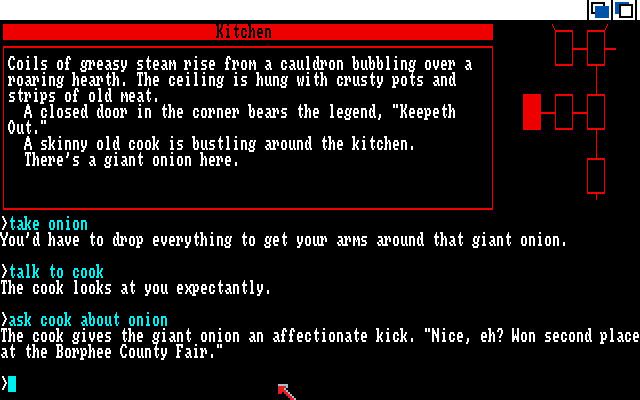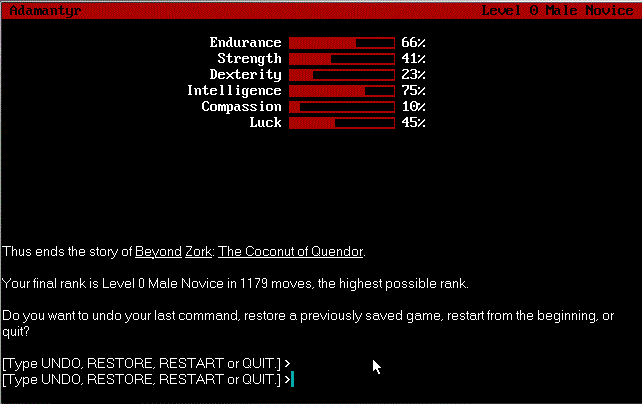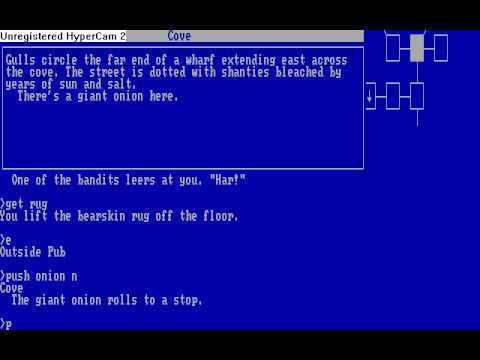8 /10 1 Votes8
4/5 Abandonware DOS Mode(s) Single player | 4/5 My Abandonware Initial release date 1987 Genre Interactive fiction | |||||||||||||||||||||||||||||||||
 | ||||||||||||||||||||||||||||||||||
Release date(s) Release 47: September 15, 1987 Release 49: September 17, 1987Release 51: September 23, 1987Release 57: December 21, 1987 Platforms DOS, Apple II, Macintosh operating systems, Atari ST, AmigaOS, Commodore 128, IBM Personal Computer, Amiga Similar Infocom games, Interactive fiction games | ||||||||||||||||||||||||||||||||||
Beyond zork unboxing pc english
Beyond Zork (full title: Beyond Zork: The Coconut of Quendor) is an interactive fiction computer game written by Brian Moriarty and released by Infocom in 1987. It was one of the last games in Infocom's Zork series; or, rather, one of the last Zork games that many Infocom fans consider "official" (titles such as Zork: Nemesis and Zork Grand Inquisitor were created after Activision had dissolved Infocom as a company and kept the "brand name"). It signified a notable departure from the standard format of Infocom's earlier games which relied purely on text and puzzle-solving: among other features, Beyond Zork incorporated a crude on-screen map, the use of character statistics and levels, and RPG combat elements.
Contents
- Beyond zork unboxing pc english
- Beyond zork the coconut of quendor gameplay pc game 1987
- Plot
- Ur grue
- Feelies
- Technical details
- Reception
- References

The game, Infocom's twenty-ninth, was available on the Amiga (512kb), Apple (128kb), Atari ST, Commodore 128, and IBM (192kb), and the Macintosh (512kb) computers.

Beyond zork the coconut of quendor gameplay pc game 1987
Plot

The player explores the Southlands of Quendor somewhat aimlessly at first. Soon, however, a task is bestowed by the Implementors, a group of godlike creatures jokingly based on Infocom's game designers. The Coconut of Quendor, an incredibly powerful artifact that embodies the whole of Magic, has fallen into the claws of an unspeakably foul beast: an Ur-grue. Rumoured to be the spirits of fallen Implementors, Ur-Grues can surround themselves in a sphere of darkness that only sunlight can pierce. The player must recover the Coconut from this monster's grasp or face the unthinkable consequences.
Ur-grue

Beyond Zork introduces the "Ur-grue", a being which game materials describe as the progenitor and ruler of the monstrous race of grues—the term "Ur-grue" combines the German prefix ur- signifying "original" and "grue"—as well as the source of many other evil monsters. He is said to have originated as the shade of a "fallen Implementor".
The Ur-Grue character in Beyond Zork may be a reference to Brian Moriarty himself, the creator of the game, who is notably absent from the game's portrayal of an "Implementors' Luncheon", where each Implementor is recognizably based on a member of the Infocom staff. His persona as the progenitor of grues and creator of monsters may be linked to his role as the creator of the games' challenges, Infocom having long made joking references to grues being the foremost example of the Implementors' capricious, sometimes nonsensical design decisions.
The Ur-grue is revealed to be the primary villain of the story. The player, sent to retrieve the Coconut of Quendor from the Implementors, arrives at the Implementors' Luncheon on the Ethereal Plane of Atrii only to find he has been followed by the Ur-grue in shadow form, who takes the opportunity to steal it for himself. The player must then venture into the Ur-grue's extensive underground lair and retrieve it.
The Ur-grue is shown to be a dungeon master of sorts, controlling huge parts of the Zork underground and having accumulated an enormous hoard of treasure, of which the Coconut is his crowning acquisition. He has not only an army of grues at his disposal but also bizarre creatures of evil such as Lucksuckers, spirits who attack the player by draining his good fortune (reducing his Luck stat). The Ur-grue himself is surrounded by a pool of magical darkness that is capable of overcoming and destroying all artificial light sources, and is therefore only vulnerable to pure sunlight—the player, therefore, can only best him by using a series of mirrors to transmit a beam of light at him from outside the dungeon.
After doing so, the Ur-grue's shadowy form is dissipated revealing what may be his true form, that of a broken, withered old man. It is implied that the Ur-grue cannot survive long in this form and must possess others' bodies, like a demon, in order to survive—he attempts to possess the player. If he succeeds, a negative ending is revealed where the possessed player-character finds and strangles baby grues until he finds one strong enough to hold the Ur-grue's essence, implying that the Ur-grue's usual shadowy form is an enhanced version of a grue's body.
If the player's Compassion stat is high enough—represented by having done enough good deeds throughout the game—the Ur-grue is shown to be unable to possess the player, his evil apparently unable to coexist in the same body with an extremely pure or virtuous spirit, and the Ur-grue's old man form fades away. Whether this means the Ur-grue was permanently destroyed in this encounter is unclear, as is the possibility of others of his kind existing somewhere in the world, although, being magical in nature, it seems unlikely any Ur-grues could survive in Quendor following the Great Change.
Feelies
Almost since the company's beginning, Infocom's games included "extras" (called feelies) in the packages, often serving a dual purpose of entertainment and copy protection. Beyond Zork is no exception. The game package contained:
Technical details
The game's most noticeable enhancement relative to its Infocom predecessors is the addition of an onscreen map to the heads-up display, which shows the player's location in relation to the surrounding area. In addition, game navigation can be accomplished via mouse clicks on the map, if the operating system that the game is running on supports mouse input.
In addition, the game continued the Zork series' early use of procedural generation in videogaming. A number of magic items have initial locations and descriptions that are randomly determined, and some sections of the area map are randomly reorganized, each time a new game is played. Role-playing game-like elements are also present in the combat, including the concept of hit points and character statistics. Infocom had used these concepts before only in a rather limited way in Zork I and III.
Like Infocom's other games, Beyond Zork is platform independent and runs on a virtual computer architecture called the Z-machine. There were 4 versions of the game released in 1987, all using version 5 of the Z-machine. The game has 144 rooms and 77 objects, with a vocabulary of 1569 words and a total of 32778 opcodes.
Reception
A review in Computer Gaming World was pleased with some of Beyond Zork's features, particularly the ability to define macros and bind them to the function keys. The randomness of the game was described as frustrating, particularly as maps and item properties randomize upon restoring a previous game save. The review concluded by describing Beyond Zork as "a curious hybrid... mostly tough Infocom adventure with a patina of role-playing elements." In 1993 the magazine stated that the game's "merging of CRPG with adventure does not mix as well as it should". The game was reviewed in 1988 in Dragon #132 by Hartley, Patricia, and Kirk Lesser in "The Role of Computers" column. The reviewers gave the game 5 stars. Compute! stated that the game's combination of text adventure and RPG "introduces the next stage in interactive fiction". It concluded, "Beyond Zork reaffirms Infocom's position as king of the text adventures".
